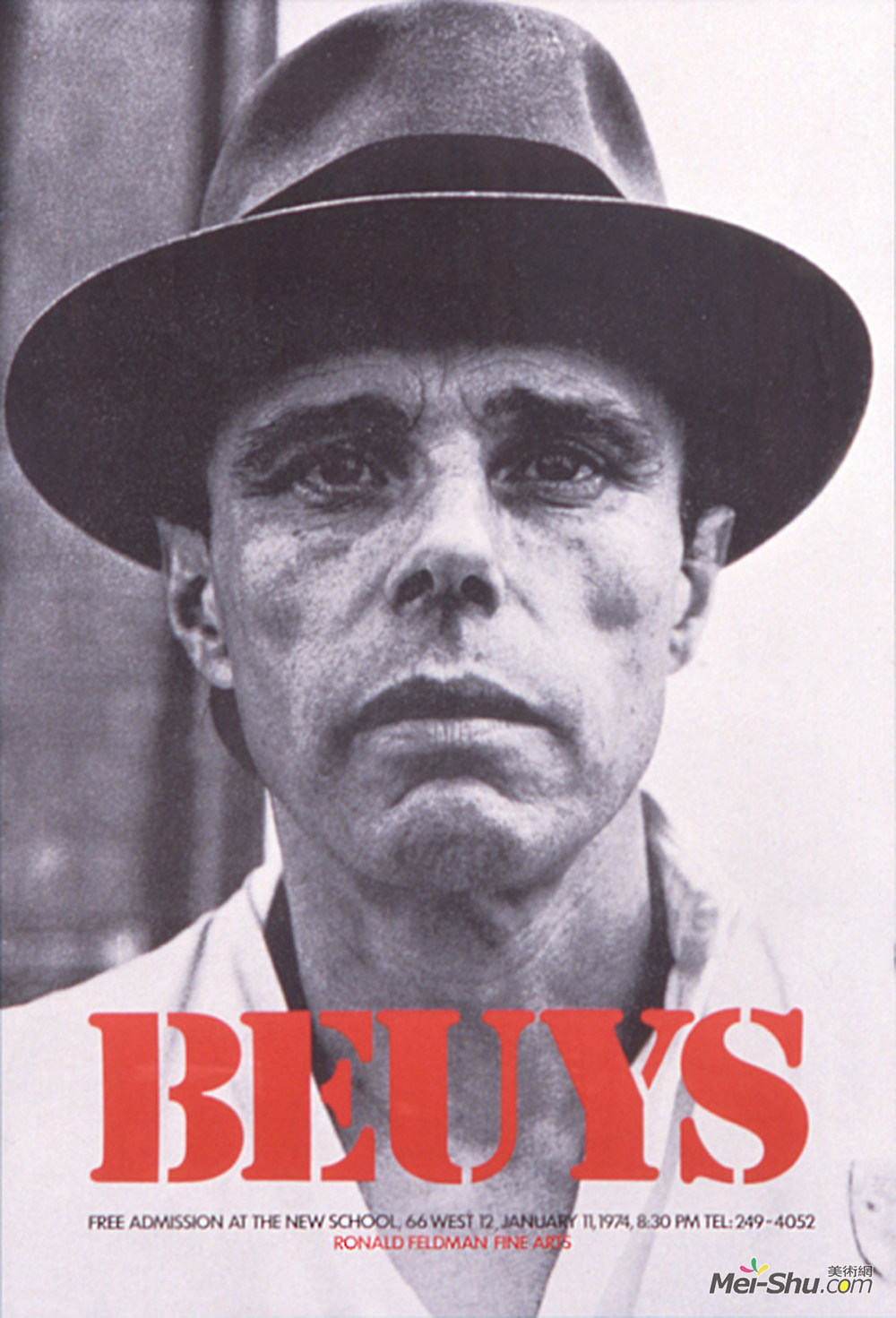
波依斯(Joseph Beuys)
艺术家: 波依斯
生于: 1921;德国Krefeld
卒于: 1986;德国杜塞尔多夫
国籍: 德国
流派: 新达达艺术,概念艺术
领域: 绘画,艺术理论,性能,安装
影响: Yoko Ono,Sigmar Polke,Robert Smithson,Rosemarie Trockel,Environmental Art,Performance Art,Fluxus
朋友: Nam June Paik,Georg Baselitz,Gerhard Richter
机构: 杜塞尔多夫艺术学院,杜塞尔多夫,德国
约瑟夫·贝伊斯是德国雕塑家、画家、装置艺术家、艺术理论家和艺术教育学家,被认为是欧洲最有影响力的表演艺术家之一。在他上学初期,他被认为是天生的绘画天才,他多次参观了阿喀琉斯·莫尔加特的雕塑工作室。他的晚年是在纳粹第三帝国时期度过的。当他15岁时,他是Hitler Youth的一员,参加了Nuremburg拉力赛。1941年,他志愿为德国空军服务,最初担任飞机无线电操作员,后来在克里米亚执行各种轰炸任务。1944,贝伊的飞机在克里米亚前线被击落。Beuys是唯一幸存下来的人,后来声称被鞑靼部落的人们救了出来,他们用动物脂肪覆盖住他,让他感到温暖,并护理他恢复健康。目击者称,尽管Beuys是唯一一个在坠机中幸存下来的人,但没有鞑靼部落成员。他被一名德国搜救突击队救出,送往一所军队医院,在那里呆了三个星期。他在同一年晚些时候被重新调派,并在1945德国投降后沦为战俘。< / P > P>他回归平民生活后,成为艺术界的活跃成员,并直言不讳地倡导人智学,认为人可以体验精神世界。通过内部开发。他在1953毕业于艺术学校,陷入了可怕的财务状况,这是他在战争中经历的创伤所造成的。到了1956岁,他面临着严重的抑郁症,由于他的物质和心理上的贫困状况,他从1959岁恢复并娶了他的妻子Eva Wurmbach。1961岁时,他被任命为杜塞尔多夫学院雕塑教授,其财务状况有所改善。正是在他任职期间,他发表了他的文章LebsnLaFuf/Wikaluf,这是对艺术家生活的一个虚构的叙述,并引起了很多争议,因为它的事实和虚构的模糊。正是在这一点上,Beuy的作品变得更加两极分化,他的叛逆的哲学和政治信仰导致他在1972的教授职位上被解雇。
P >很多Buyes最受欢迎的作品是他的表演和安装作品,包括“如何解释图片”。1965年的《献给死兔》、《我喜欢美国,美国喜欢我》于1974年,以及涉及在德国种植7000棵树的社会雕塑项目。他的遗产现在包括世界各地的几十个展览,继续参与他的橡树社会雕塑,扩大到纽约市,并在拍卖会上销售他的作品不断增加。
Artist :Joseph Beuys
Additional Name :Joseph Beuys
Born : Krefeld, Germany
Died : Düsseldorf, Germany
Nationality :German
Art Movement :Neo-Dada,Conceptual Art
Field :painting,art theory,performance,installation
Influenced on :yoko-ono,sigmar-polke,robert-smithson,rosemarie-trockel,artists-by-art-movement/environmental-art,artists-by-art-movement/performance-art,artists-by-painting-school/fluxus
Friends and Co-workers :nam-june-paik,georg-baselitz,gerhard-richter
Art institution :Kunstakademie Düsseldorf, Düsseldorf, Germany
Joseph Beuys was a German sculptor, painter, installation artist, art theorist and art pedagogue, and is considered one of the most influential European performance artists. In his early school years, he was considered to have a natural talent for drawing, and he visited the sculpting studio of Achilles Moortgat many times. His later childhood was spent in the era of the Nazi Third Reich. When he was 15 years old, he was a member of the Hitler Youth, and participated in the Nuremburg rally. In 1941, he volunteered for the German Luftwaffe, first acting as an aircraft radio operator, and later part of various bombing missions in the Crimea. In 1944, Beuy’s plane was shot down on the Crimean Front. Beuys was the only person to survive the crash, and later claimed to have been rescued by Tartar tribesmen, who covered him with animal fat and felt to keep him warm and nursed him back to health. Eyewitness accounts, however, claim that although Beuys was the only one to survive the crash, there were no Tartar tribesmen. He was instead rescued by a German search commando, and taken to a military hospital where he stayed for three weeks. He was redeployed later the same year, and held as a prisoner of war after the German surrender in 1945.
Upon his return to civilian life, Beuys became an active member in the art community, and an outspoken proponent of anthroposophy, which posited that one could experience the spiritual world through inner development. He graduated from art school in 1953, to a dire financial situation, which was compounded by the traumas he experienced in war. By 1956, he was facing a serious depression, due to his materially and psychologically impoverished situation, from which he recovered and married his wife Eva Wurmbach in 1959.
Beuy’s financial situation improved in 1961 when he was appointed professor of sculpture at the Dusseldorf Academy. It was during his tenure at the academy that he released his essay Lebenslauf/Werklauf, which was a somewhat fictionalized account of the artist’s life, and created much controversy, due to its blurring of fact and fiction. It was at this point that Beuy’s work became more polarizing, and his renegade philosophical and political beliefs led to his dismissal from his professorial position in 1972.
Much of Beuys most popular works were his performance and installation pieces, including “How to Explain Pictures to a Dead Hare” in 1965, “I Like America and America Likes Me” in 1974, and a social sculpture project that involved planting 7,000 trees in Germany. His legacy now includes dozens of exhibition all across the world, continued participation in his oak tree social sculpture, which has expanded to New York City, and growing sales of his work at auction.